New source of greenhouse gas: scientific discoveries and environmental consequences
Researchers at Caltech have made a significant discovery: They have discovered a new type of enzyme that allows a variety of bacteria utilizing nitrates for respiration when oxygen levels are low.
The scale of nitrous oxide production and its impact on agriculture and the environment
This process leads to the formation of nitrous oxide (N₂O), a powerful greenhouse gas that has the third largest impact on the climate following carbon dioxide and methane. Unlike carbon dioxide, nitrous oxide does not stay in the atmosphere for long,so measures to reduce its emissions can produce quick results. For example, Careful use of fertilizers can lower nitrous oxide emissions and save farmers money. It is now clear that the number of bacteria producing nitrous oxide significantly exceeds previous estimates,” says Professor Woody Fisher.
Understanding the sources of this gas assists in making better-informed decisions. Farmers will be able to take into account the microbial communities in the soil to use fertilizers more efficiently.
The study, published in the journal Proceedings of the National Academy of Sciences, was led by Ranjani Murali and James Hemp. The team examined the genome sequences of tens of thousands of microbes and identified many reductases that encode proteins for using nitric oxide in respiration. This process occurs in environments ranging from wetlands to alpine soils where oxygen levels are low.

The discovery changes the understanding of the development of metabolic pathways in microbes. This suggests that the proteins responsible for nitrate respiration evolved from those that used oxygen for respiration about two billion years ago.
“Using automated metabolomic analysis without experimental validation can lead to erroneous conclusions,” cautions James Hemp. This research greatly advances our understanding of enzymes involved in microbiological processes.
The study’s co-authors also included scientists who previously held graduate studies and teaching positions at the California Institute of Technology, the University of Nevada, the University of Illinois, and Montana State University.
The impact of greenhouse gases on agriculture: challenges and adaptation to climate change
This fact Is crucial due to the substantial influence of greenhouse gases on agriculture, primarily through changes in climatic conditions and environmental parameters:
1. Climate Change: Rising concentrations of greenhouse gases like carbon dioxide, methane, and nitrous oxide are causing alterations in climate conditions. This can result in higher temperatures, altered precipitation patterns, and an increase in extreme weather events such as droughts and floods.. These changes can significantly impact crop growth, yield and distribution of planted areas.
2. Plant resistance: Increasing temperatures and changing precipitation patterns can lower crop resistance to diseases, pests, and stress conditions. This can lead to a decrease in yield and product quality.

3. Water resources: Changes in precipitation and temperature also affect the availability and quality of water for agriculture. Uneven distribution of precipitation can lead to instability in water supplies, which is critical for agriculture and livestock production.
4. Biodiversity and ecosystems: Climate change is affecting biodiversity and the health of ecosystems that underpin agricultural production. Declining biodiversity and ecosystem degradation can reduce the potential for sustainable agriculture and threaten food security.
All these factors highlight the necessity to decrease greenhouse gas emissions and adapt agriculture to changing climate conditions to ensure sustainable development and food security.








